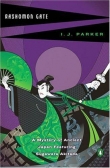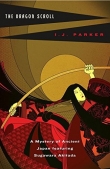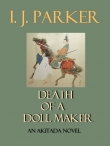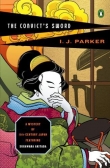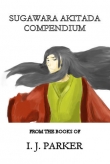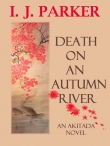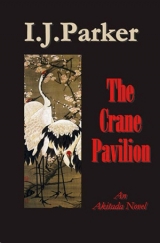
Текст книги "The Crane Pavilion "
Автор книги: Ingrid J. Parker
Жанр:
Исторические детективы
сообщить о нарушении
Текущая страница: 18 (всего у книги 18 страниц)
34
Senior Secretary Soga
The student Takechi Akushiro was arrested. The professor, perhaps because of his outrage over the moral turpitude of the younger generation, accompanied Tora to police headquarters to support his charges against him. The student confessed readily, though not without putting blame on Lady Ogata for having provoked him.
The case was closed, and yet Akitada felt dissatisfied. There was the matter of Lady Ogata’s real identity. On his instructions, Tora had not revealed this to the police, but Akitada felt her family should know of her death.
But he was not equal to taking such a tale to a man like Senior Secretary Soga and was still fretting when, to his consternation, Saburo admitted the Senior Secretary to his study the next day.
Soga Ietada, tall and thin, walked in briskly, cast a curious glance around at all the books collected by Akitada and a long line of learned Sugawaras, and a more penetrating one at Akitada. His expression was grim.
Akitada knelt and bowed deeply, ignoring the pain in his back, and wondering what new disaster was about to strike.
“Please be comfortable, Sugawara,” said the secretary. “I understand you are recovering from a knife attack?”
“Yes, Excellency. Thank you. Saburo, a cushion for his Excellency and some refreshments.”
“No refreshments.” Soga sat down. “And please, no interruptions either. I have private business with your master.”
Saburo bowed and withdrew.
Akitada said quickly, “I should have come in person to express my thanks that you … that His Excellency the Prime Minister has decided to overlook my precipitate departure from Kyushu, but as you know I’ve not been well.” Flushing with embarrassment, he stumbled on, “And of course I’m also grateful for the generous remittance of my past salary.”
Soga’s grim look did not change. He said, “What? Oh, yes. But I’m not here about that.”
Could this have something to do with Soga’s daughter? But how had he found out? This time Akitada waited.
Soga sighed deeply. “I understand you are acquainted with Abbot Genshin?”
“We were students together.”
“Ah. His Reverence came to see me late last night because some news had reached him. He told me a rather strange story that involved you also.” Soga paused.
Akitada nodded. “Please continue, Excellency.”
“It seems about five years ago he found a young noblewoman living in great poverty and brought her to his Takashina mansion. She called herself Lady Ogata. She remained there, living quietly, until some three weeks ago when the abbot’s caretaker found she had hanged herself.” Soga shuddered, but his voice was level when he continued. “At any rate, the police called it a suicide, but the abbot tells me, you thought this death suspicious. Is this true?”
“Yes, Excellency. The young lady was murdered. Yesterday the police arrested a student who confessed to strangling her and creating the scenario the police found.”
Soga nodded, his eyes probing Akitada’s. “That is what brought Abbot Genshin to me. That and the knowledge he had.” He paused, obviously deeply pained, then tried again, “You see, he knew that I have, or had, a daughter …” He stopped again and closed his eyes.
Akitada said gently, “Yes, your Excellency. I believe Lady Ogata was indeed your daughter. I’m deeply sorry.”
The Senior Secretary opened his eyes and heaved a deep sigh. “Thank you. That was the question I wanted to ask. You are quite certain?”
“Not certain, but it seemed likely, given the facts. If it won’t pain you too much, allow me to tell you what I learned.”
Soga nodded and Akitada told the story of his investigation. When he was done, Soga said, “Yes, it all seems to fit. My poor child! She left the nunnery when a rumor reached her that Masakane had escaped. She hoped he would send for her but dared not tell anyone about it. Alas, the rumor was false, but she never knew. She never knew.” He shook his head, then rose and walked to the door.
Akitada struggled to his feet. “I’m very sorry, Excellency,” he said again.
Soga turned. His face was wet with tears. “Forgive me,” he said. “I should have thanked you properly. I think you will keep her secret. My poor child’s death would rake up the old scandal, and I don’t want her memory to become court gossip again.”
Akitada bowed. “You have my word, Excellency.”
Soga still hesitated. “I’m glad the unfortunate matter of your return from Kyushu was settled. I understand your former position was given to someone else?”
Akitada hesitated. “Yes, your Excellency, but I gave my word without any condition.”
“I understand, but I wish to be of some service to you. It would help me deal with my loss.”
For a moment, Akitada’s mind rebelled against trading his silence for Kobe’s reinstatement, then he said, “I was told that Superintendent Kobe was unjustly removed from his position on the word of a junior official in the Ministry of Justice. If your Excellency would look into this matter, I think not only I but the people of the city would be grateful.”
Soga came back and sat down again. “Tell me about this.”
After the Senior Secretary had left, Akitada sat for a long time, thinking about the strong young woman whose love had defied an emperor and her family’s wishes, yes, even convention and danger to be with Masakane. It sickened him that she should have died at the hands of a pathetic weakling who knew nothing of love or loyalty.
Akitada finally rose with a sigh and walked outside where crimson maple leaves covered the moss as if the tree had bled to death.
A squirrel came to stir them up and paused to stare at him. For a moment, man and animal became motionless in time. Then the shouts of children playing broke their trance. The squirrel fled, and life went on.
HISTORICAL NOTE
Heian Japan (794-1185) took much of its culture, government, and religion from China. However, by the time of this novel (1029), contact with China had long been discontinued, and many of the original institutions had taken on Japanese characteristics.
The central government structure with an emperor at its head and a ruling hierarchy of officials to administer the many provinces of Japan still existed, but it was no longer a meritocracy as in China, where only the best and most learned rose to office in the civil service, but rather a hereditary bureaucracy by the nobility and centered primarily in one family, the Fujiwaras. The Fujiwaras furnished all the top officials and most of the empresses. They saw to it that emperors abdicated young, to be replaced by another, even younger, ruler who could be manipulated by his maternal grandfather and uncles.
Culture, however, flourished under this system. The aristocracy prized learning, writing, music, and the arts. A court lady wrote Genji, the first novel in the world in the early years of the eleventh century. Because of all the literary activity of the time, much is known about life at court and the lives of the nobility. Much less is known about ordinary people.
They lived in the cities, where they provided goods and services to noble families, and in the country, where they were mostly peasants, raising the all-important rice crops. Heian-kyo (modern Kyoto) was the capital and the seat of government. Laid out in the eighth century according to Chinese precepts in a rectangle with a grid of major and minor streets, it followed feng shui principles, having mountains to its north and rivers to the west, east, and south.
The northernmost third was occupied by the Daidairi, a government city within the city, and by the palaces of the nobility. The Daidairi contained the imperial palace, ceremonial halls, and buildings housing the various ministries, the guards’ barracks, the horse stables, and offices supplying goods to the palace. The entire area was walled and gated.
The capital itself never had walls, but it had gates, the most important of which was Rashomon to the south. By the eleventh century, this gate may no longer have existed. Other parts of the original city also fell into ruin. The entire western half of the city became a dangerous haunt of the poor and criminal elements. Business was concentrated in the eastern half.
It should be noted that there is no evidence that Heian-kyo had a “willow quarter” at this time. However, prostitution was common, especially in the brothel towns on the Yodo River south of the capital. Female entertainers also traveled the country in groups, offering their services, both as dancers and singers and as sexual partners. It is likely that some area of the city would have offered such services on a permanent basis. Some of the details about prostitution in early Japan are based on scholarly works for the period, but many also come from later Japanese literature on the subject.
The architectural style of Japanese buildings can still be seen in many of the temples from the period. The entire Daidairi would have been built this way, with the gracefully curved roofs, either covered with greenish blue glazed tiles or, like the imperial palace, with a dark bark roof. The buildings were always of wood, constructed with huge pillars resting on large flat stones. Floors were raised above ground, verandas surrounded them, and the large interior spaces could be separated into rooms by movable walls and screens. Doors were solid or shuttered, and when they stood open, reed shades could be lowered for privacy. This construction method made even the largest and most elaborate buildings subject to destruction by fire or earthquake, but they had the advantage of being easy to rebuild or move. In fact, the Japanese repeatedly moved their entire capital from one place to another when it seemed advantageous.
The nobility lived in large mansions, sometimes occupying whole city blocks, which were walled and gated and consisted of a main house with galleries leading to wings and to separate pavilions. They had elaborate gardens in the back and service areas in the front.
Ordinary people lived in much simpler abodes. Here again there is little information. In my books, any references to their dwellings are based on pictures from later periods.
This particular novel contains several terms that may need special explanation. The idea that life in this world is a “floating bridge,” i.e. immaterial and transitory, is based on Buddhist teachings, another import from China. The concepts of hell and paradise are also derived from this faith, which coexisted with the native Shinto religion. The religious figures in this novel are all Buddhist: Abbot Genshin and Nun Seikan have renounced the world, i.e. chosen a life of poverty and celibacy in order to worship Buddha. The young woman Sadako was briefly a nun, having been forced to withdraw from the world because of her husband’s capital crime. Choosing a religious life as a rule protected people from harsh sentences and confiscation of property. Genshin had made this choice in his youth.
Medical knowledge in the eleventh century was fairly primitive and consisted mainly of prescribing herbal medicines, acupuncture, and moxa treatments. Medical practitioners could come from different backgrounds, being frequently monks or pharmacists, but the Imperial University also trained physicians.
The issue of money is a troublesome one for anyone writing fiction set in eleventh century Japan. Most scholarly texts assure us that Japan had a rice economy; i.e. rice was used in a barter system. In fact, other valuable things, like rolls of silk or horses, could also be used to pay bills, reward people, or present as gifts. Officials were paid by being given rice farms for their livelihood, and a man’s wealth was judged by how many manors and rice fields he owned. Rice could also be given as a loan against future harvests, when it had to be repaid with interest. Monasteries and temples were in the rice lending business. But actual money existed and came in the form of coins that were copper, silver, or gold. Gold and silver bars were also available. Men must have been provided with some ready cash for daily expenses. Japan imported coins from China, but it also pursued gold and silver mining aggressively. On the other hand, there is no evidence that moneylenders like Nakamura and Saito existed in the eleventh century. They became common later.
About the Author
I.J. Parker was born and educated in Europe and turned to mystery writing after an academic career in the U.S. She has published her Akitada stories in Alfred Hitchcock’s Mystery Magazine, winning the Shamus award in 2000. Several stories have also appeared in collections, such as Fifty Years of Crime and Suspense and the recent Shaken. The award-winning “Akitada’s First Case” is available as a podcast. Many of the stories have been collected in Akitada and the Way of Justice.
The Akitada series of crime novels features the same protagonist, an eleventh century Japanese nobleman/detective. Death on an Autumn River is number nine. The books are available on Kindle. Many are also in print in audio format and have been translated into twelve languages.
Also by I. J. Parker
The Akitada series in chronological order
The Dragon Scroll
Rashomon Gate
Black Arrow
Island of Exiles
The Hell Screen
The Convict’s Sword
The Masuda Affair
The Fires of the Gods
Death on an Autumn River
The Emperor’s Woman
Death of a Doll Maker
The Crane Pavilion
The collected stories
Akitada and the Way of Justice
The HOLLOW REED SAGA
Dream of a Spring Night
Dust before the Wind
The Sword Master
The Left-Handed God
Contact Information
Please visit I.J.Parker’s web site here.
You may contact her via e-mail at Heianmys@aol.com. (This way you will be contacted when new books come out.)
Books may be ordered from Amazon and Barnes&Noble in print and as e-books. The novels are on Kindle here. The short stories are on Kindle and Nook. Please do post Amazon reviews. They help sell books and keep Akitada novels coming.
Thank you for your support.
Table of Contents
Praise for I. J. Parker and the Akitada series
Pronunciation of Japanese Words
Characters
1 Koshiro
2 The Sadness of Autumn
3 A Conspiracy
4 The Old Professor
5 The Student
6 Murder in a Bathhouse
7 The Caretaker and the Artist
8 Talk of the Town
9 The Tides of Life
10 The Moneylenders
11 Fire in a Jar
12 The Blind Girl
13 A Hopeless Case
14 Gossip in the Bath
15 In Disgrace
16 The Gamblers
17 The Nun
18 A Tiger in the Dark
19 The Dance of the Cranes
20 Lady Akiko’s News
21 Arrest
22 An Old Acquaintance
23 A Good Name is Forever
24 The Search
25 Phoenix
26 Walk into Danger
27 Rising Mist
28 Twilight before the Dark
29 Kobe Risks All
30 The Quiet Sadness of Autumn Rain
31 The Bridge of Dreams
32 A Lotus Flower in the Mud
33 The Lady of the Crane Pavilion
34 Senior Secretary Soga
HISTORICAL NOTE
About the Author
Also by I. J. Parker
Contact Information
